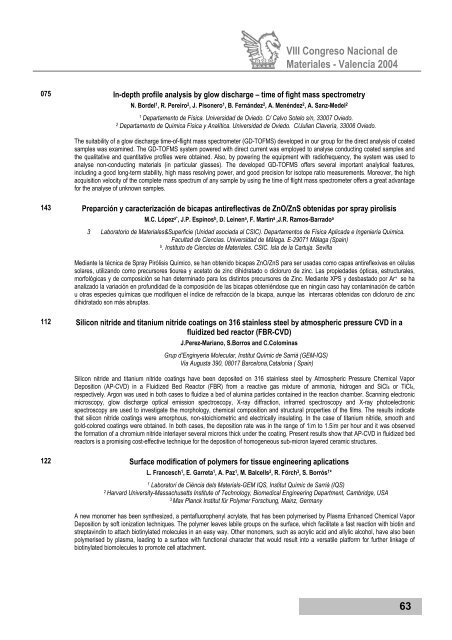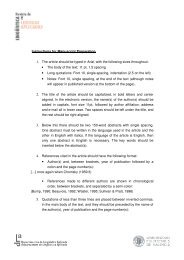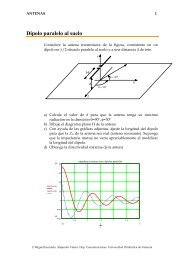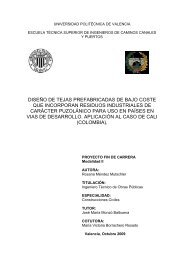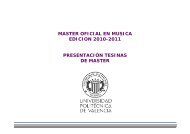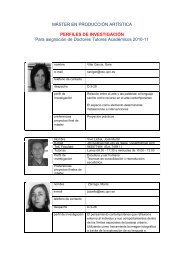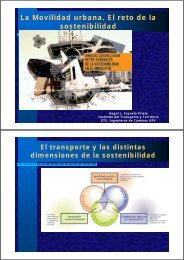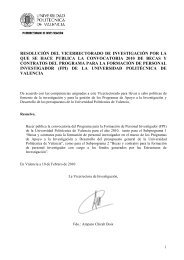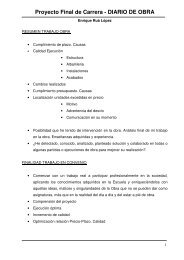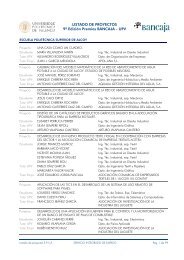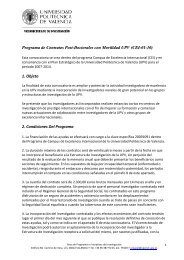materiales cerámicos. síntesis y procesado - Universidad ...
materiales cerámicos. síntesis y procesado - Universidad ...
materiales cerámicos. síntesis y procesado - Universidad ...
You also want an ePaper? Increase the reach of your titles
YUMPU automatically turns print PDFs into web optimized ePapers that Google loves.
VIII Congreso Nacional de<br />
Materiales - Valencia 2004<br />
075 In-depth profile analysis by glow discharge – time of fight mass spectrometry<br />
N. Bordel 1 , R. Pereiro 2 , J. Pisonero 1 , B. Fernández 2 , A. Menéndez 2 , A. Sanz-Medel 2<br />
1 Departamento de Física. <strong>Universidad</strong> de Oviedo. C/ Calvo Sotelo s/n, 33007 Oviedo.<br />
2 Departamento de Química Física y Analítica. <strong>Universidad</strong> de Oviedo. C/Julian Clavería, 33006 Oviedo.<br />
The suitability of a glow discharge time-of-flight mass spectrometer (GD-TOFMS) developed in our group for the direct analysis of coated<br />
samples was examined. The GD-TOFMS system powered with direct current was employed to analyse conducting coated samples and<br />
the qualitative and quantitative profiles were obtained. Also, by powering the equipment with radiofrequency, the system was used to<br />
analyse non-conducting materials (in particular glasses). The developed GD-TOFMS offers several important analytical features,<br />
including a good long-term stability, high mass resolving power, and good precision for isotope ratio measurements. Moreover, the high<br />
acquisition velocity of the complete mass spectrum of any sample by using the time of flight mass spectrometer offers a great advantage<br />
for the analyse of unknown samples.<br />
143 Preparción y caracterización de bicapas antireflectivas de ZnO/ZnS obtenidas por spray pirolisis<br />
M.C. Lópeza* , J.P. Espinosb , D. Leinena , F. Martina ,J.R. Ramos-Barradoa 3 Laboratorio de Materiales&Superficie (Unidad asociada al CSIC). Departamentos de Física Aplicada e Ingeniería Química.<br />
Facultad de Ciencias. <strong>Universidad</strong> de Málaga. E-29071 Málaga (Spain)<br />
b . Instituto de Ciencias de Materiales. CSIC. Isla de la Cartuja. Sevilla<br />
Mediante la técnica de Spray Pirólisis Químico, se han obtenido bicapas ZnO/ZnS para ser usadas como capas antireflexivas en células<br />
solares, utilizando como precursores tiourea y acetato de zinc dihidratado o dicloruro de zinc. Las propiedades ópticas, estructurales,<br />
morfológicas y de composición se han determinado para los distintos precursores de Zinc. Mediante XPS y desbastado por Ar + se ha<br />
analizado la variación en profundidad de la composición de las bicapas obteniéndose que en ningún caso hay contaminación de carbón<br />
u otras especies químicas que modifiquen el índice de refracción de la bicapa, aunque las intercaras obtenidas con dicloruro de zinc<br />
dihidratado son más abruptas.<br />
112 Silicon nitride and titanium nitride coatings on 316 stainless steel by atmospheric pressure CVD in a<br />
fluidized bed reactor (FBR-CVD)<br />
J.Perez-Mariano, S.Borros and C.Colominas<br />
Grup d’Enginyeria Molecular, Institut Químic de Sarrià (GEM-IQS)<br />
Via Augusta 390, 08017 Barcelona,Catalonia ( Spain)<br />
Silicon nitride and titanium nitride coatings have been deposited on 316 stainless steel by Atmospheric Pressure Chemical Vapor<br />
Deposition (AP-CVD) in a Fluidized Bed Reactor (FBR) from a reactive gas mixture of ammonia, hidrogen and SiCl4 or TiCl4,<br />
respectively. Argon was used in both cases to fluidize a bed of alumina particles contained in the reaction chamber. Scanning electronic<br />
microscopy, glow discharge optical emission spectroscopy, X-ray diffraction, infrarred spectroscopy and X-ray photoelectronic<br />
spectroscopy are used to investigate the morphology, chemical composition and structural properties of the films. The results indicate<br />
that silicon nitride coatings were amorphous, non-stoichiometric and electrically insulating. In the case of titanium nitride, smooth and<br />
gold-colored coatings were obtained. In both cases, the deposition rate was in the range of 1 m to 1.5 m per hour and it was observed<br />
the formation of a chromium nitride interlayer several microns thick under the coating. Present results show that AP-CVD in fluidized bed<br />
reactors is a promising cost-effective technique for the deposition of homogeneous sub-micron layered ceramic structures.<br />
122 Surface modification of polymers for tissue engineering aplications<br />
L. Francesch 1 , E. Garreta 1 , A. Paz 1 , M. Balcells 2 , R. Förch 3 , S. Borrós 1 *<br />
1 Laboratori de Ciència dels Materials-GEM IQS, Institut Químic de Sarrià (IQS)<br />
2 Harvard University-Massachusetts Institute of Technology, Biomedical Engineering Department, Cambridge, USA<br />
3 Max Planck Institut für Polymer Forschung, Mainz, Germany<br />
A new monomer has been synthesized, a pentafluorophenyl acrylate, that has been polymerised by Plasma Enhanced Chemical Vapor<br />
Deposition by soft ionization techniques. The polymer leaves labile groups on the surface, which facilitate a fast reaction with biotin and<br />
streptavindin to attach biotinylated molecules in an easy way. Other monomers, such as acrylic acid and allylic alcohol, have also been<br />
polymerised by plasma, leading to a surface with functional character that would result into a versatile platform for further linkage of<br />
biotinylated biomolecules to promote cell attachment.<br />
63


